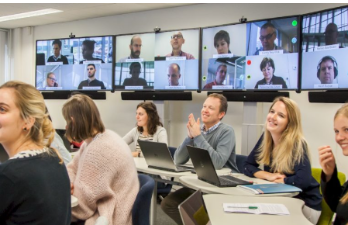In the "Internet +" era, the traditional face-to-face one-way transmission teaching model of schools can no longer meet the needs of students in the digital age. With the sound of the future school fantasy, blended learning (Blended Learning) that combines the advantages of traditional classrooms and online learning is gradually becoming the mainstream teaching organization method.
In the "Internet +" era, the traditional face-to-face one-way transmission teaching model of schools can no longer meet the needs of students in the digital age. With the sound of the future school fantasy, blended learning (Blended Learning) that combines the advantages of traditional classrooms and online learning is gradually becoming the mainstream teaching organization method.
Definition and development of blended teaching
The blended teaching model, a teaching model that combines the advantages of traditional classrooms and online learning, is increasingly attracting widespread attention in the field of education. It combines many advantages of traditional teaching and online teaching, and thus becomes the new favorite of teaching in the "Internet +" era. The American Training and Development Association even listed it as one of the top ten important trends in the knowledge dissemination industry.
This model not only combines the advantages of traditional teaching, but also combines the convenience and efficiency of online teaching, thereby giving full play to the leading role of teachers in teaching, and at the same time fully stimulating the initiative, enthusiasm and creativity of students' learning.

It is worth noting that the blended teaching model is not a simple superposition of traditional teaching and online teaching. It covers the deep interactive integration of various teaching forms, such as lectures, discussions, research, case studies, etc., as well as the organic integration of various teaching strategies.
With the progress of the times and the development of society, more new teaching forms will be integrated into this model in the future, enriching the connotation of the hybrid teaching model. But in general, hybrid teaching is an organic combination of online learning and traditional classroom teaching, aiming to optimize teaching effects and give full play to the dual roles of teachers and students.
Types of hybrid teaching models
According to different implementation methods, hybrid teaching models can be classified into many types, including hybrid learning with fixed weekly meetings, autonomous hybrid learning with free arrangement of learning time, and teaching project-based learning that combines face-to-face teaching and the Internet. These different types have different focuses in curriculum setting, teacher-student interaction and learning assessment, but all highlight the flexibility and diversity of hybrid teaching.
Impact of hybrid teaching model
With the widespread popularization of digital networks and the rapid development of information technology, the hybrid teaching model is highly respected in the global education community. It not only conforms to the trend of the times, but also becomes an indispensable driving force for China's higher education reform. The core concept of the hybrid teaching model lies in the re-examination and optimization design of the relationship between teaching and learning. In the field of education reform, the issue of teaching and learning has always occupied a pivotal position, and the hybrid teaching model has become an important tool for promoting educational innovation and change by emphasizing students' subjectivity and learning initiative, as well as using diverse teaching methods and information technology.
▍ Promotion of students' deep learning
The hybrid teaching model has a significant effect on promoting students' deep learning. Through the organic combination of online and offline and diversified teaching methods, students can conduct in-depth exploration and thinking in a more autonomous and open learning environment. This not only improves students' learning effects and comprehensive qualities, but also lays a solid foundation for their future career development. This model not only finds a balance in the integration of online and offline teaching methods, but also realizes the interweaving and sublimation of multiple teaching theories at a deep level.
▍ Promotion of teacher role transformation
Under the hybrid teaching model, the role of teachers has changed significantly. They are no longer just knowledge transmitters, but also guides and inspirers in the students' learning process. This transformation not only challenges the traditional classroom teaching model, but also stimulates students' enthusiasm for learning and creativity, and promotes the in-depth development of college classroom teaching reform.

Implementation strategy of hybrid teaching mode
▍Building intelligent teaching environment
The implementation of hybrid teaching mode is inseparable from intelligent teaching platform. First, it is necessary to strengthen the construction of wireless campus network and build an all-weather, full-coverage, full-application network environment so that students can learn anytime and anywhere. Secondly, schools should independently develop teaching platforms to support flexible conversion of in-class and out-of-class teaching and meet the learning needs of different students. The construction of intelligent teaching platform and wireless network is the basis for implementing hybrid teaching.
▍Improving teachers' information technology capabilities
The hybrid teaching mode poses new challenges to teachers, especially in terms of information technology application capabilities. Therefore, it is necessary to provide relevant training for teachers to help them master the necessary information technology skills, such as the operation of online teaching platforms and the use of multimedia teaching resources. By improving teachers' information technology capabilities, it can better support the implementation of hybrid teaching mode and promote the improvement of teaching quality. The TPACK model emphasizes the integration of technology in teaching to improve teaching effectiveness.
▍Implementation of teaching activities in cloud environment
With the deep integration of the Internet, cloud computing, big data and artificial intelligence with education, the realization of hybrid teaching mode has become more possible. With the help of information technology, the "cloud-integrated" education cloud service system has promoted the development of interactive, experiential and hybrid teaching.
Digital course resources are the key to the efficient development of the hybrid teaching model. Micro-course resources optimize teaching content by effectively integrating and rebuilding the course ecology.

▍ Establish an information-based teaching strategy
In the process of implementing the hybrid teaching model, it is crucial to build an effective information-based teaching strategy. This includes using information technology to optimize teaching design, innovating teaching methods, and making full use of digital resources to support students' learning. At the same time, teachers need to continuously improve their information technology application capabilities to better adapt to and implement the hybrid teaching model. This teaching model not only meets the requirements of cultivating students' core literacy and promoting in-depth learning, but also effectively improves classroom participation and optimizes learning outcomes.
